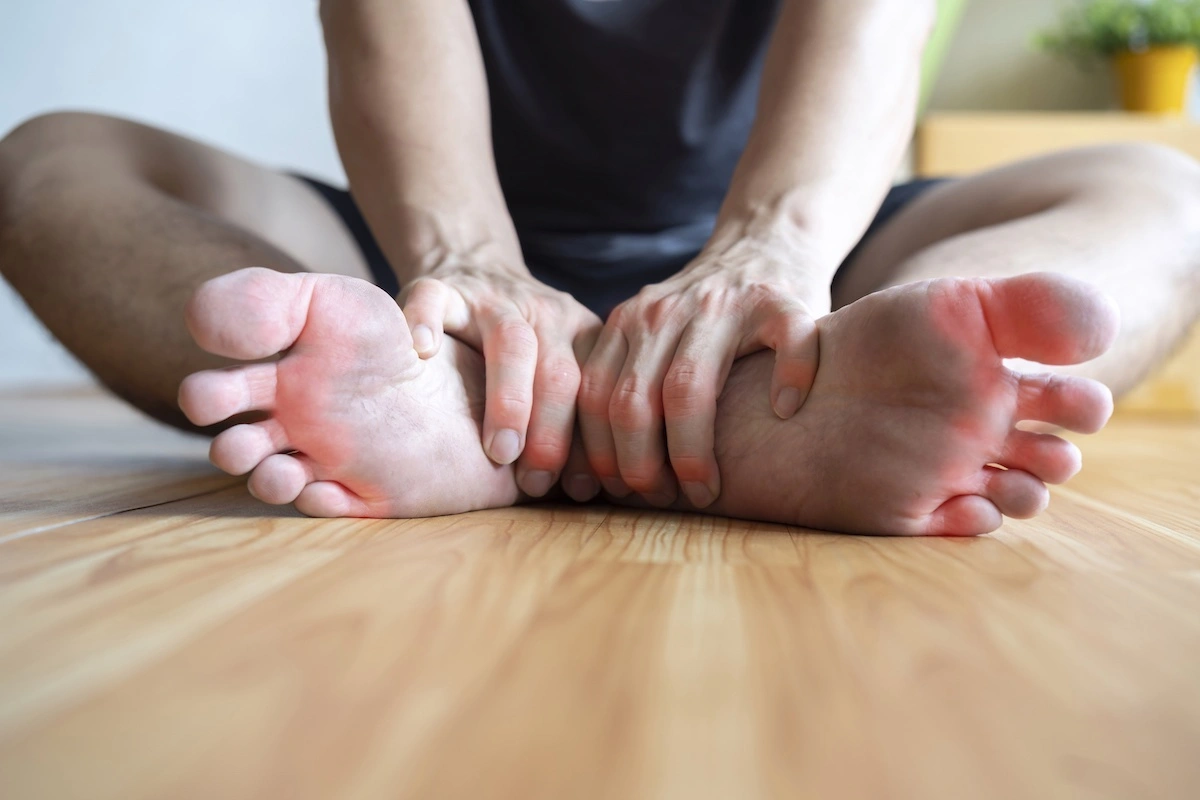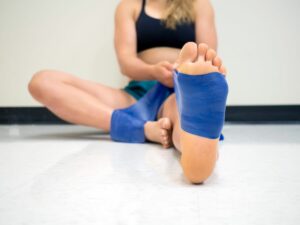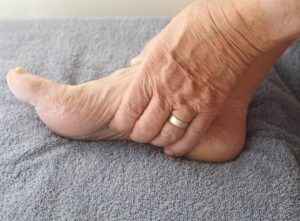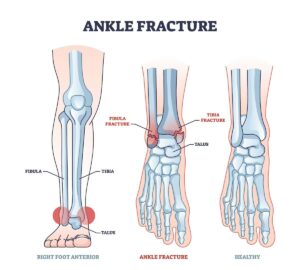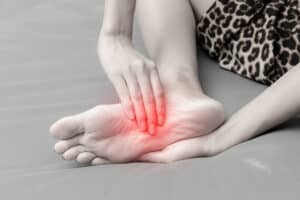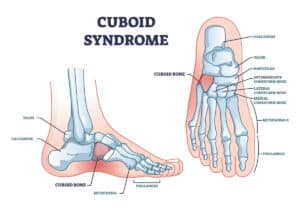Free download: Top 10 Natural & Easy Remedies for Joint Pain from Home. Learn these helpful remedies.
Estimated Reading Time: 10 minutes read
Foot supination is what occurs when the foot rolls to its outer edge. While this is actually a normal position to pass through while walking, too much of anything isn’t necessarily a good thing.
If foot supination is a normal part of walking, at what point does it become a bad thing? What causes excessive supination? More importantly, how do you correct supination? We’ll answer all of these questions and talk about the best exercises to correction foot supination.
Table of Contents
Normal Foot Supination During Walking
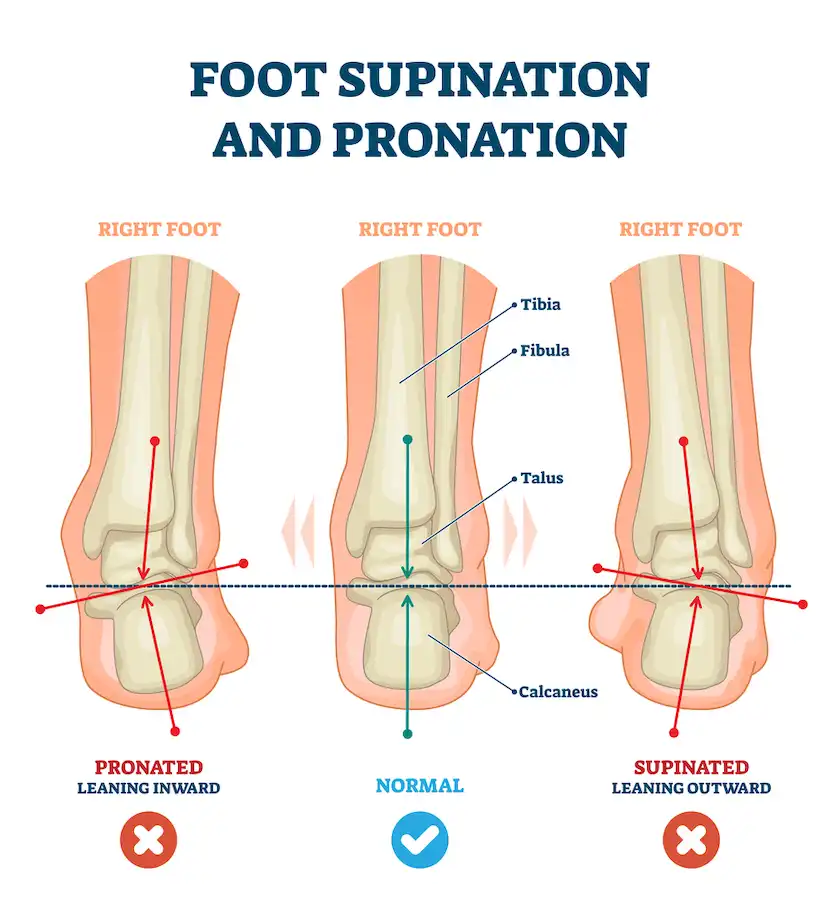
As mentioned above, some degree of foot supination is actually normal and necessary while walking.
Now, we won’t get into too much detail about all the specifics of the walking or the gait cycle, but there are a couple of key points helpful to know.
Generally speaking, the shape of the foot can affect the loading forces when you take a step. Abnormal alignment, such as with excess supination, can create abnormal forces while walking. This can make you more susceptible to pain and injury.
When you take a step and reach the point where the foot is flat on the ground, the foot cushions the weight of the body. This helps to absorb shock as you take a step.
As you continue to move forward, the foot keeps moving to propel you forward. It does this by becoming more rigid (this is where natural supination comes in).
Causes of Excessive Supination of the Foot
Foot supination can be causes by the natural structure of the foot and ankle, or it could be related to positional or muscle imbalances.
Structural Causes:
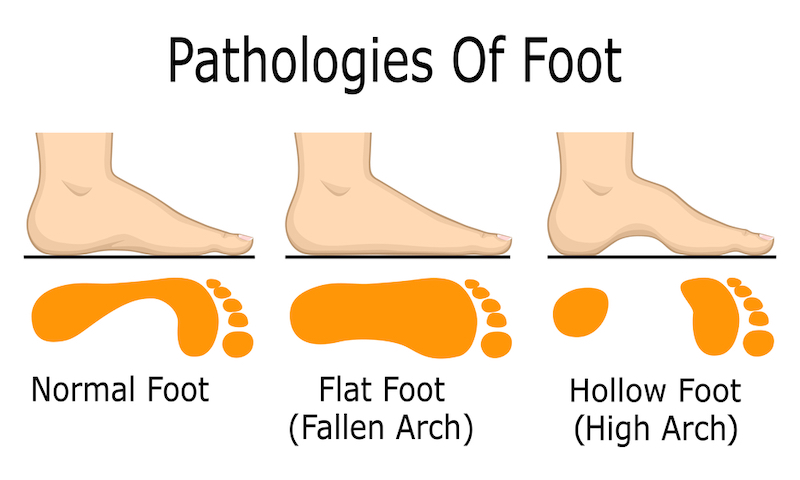
One of the most common structural issues that contributes to supinated foot postures is high arches. High arches could be the result of the natural alignment and positioning of the foot and ankle bones and/or surrounding soft tissues.
High arches tend to create excessive tightness on the bottom or plantar surface of the foot. This can create excessive rigidity in the foot’s arch, and then excessive supination occurs.
Functional Imbalances:
Functional imbalances that may create risk for excessive supination can include the following:
- Prior injury, such as an ankle sprain
- Plantar fasciitis
- Improper footwear, creating excessive rigidity in the arches
- Tight muscles, especially calf muscles
- Weak leg muscles
What Can Happen if You Don’t Correct Supination?

If the foot is not able to perform its normal role of shock absorption and loading of the body while walking, you’ll be at a higher risk of injury. The following are some of the most common injuries associated with supination:
- Inversion ankle sprain
- Shin splints
- Plantar fasciitis
- Stress fractures
- Foot pain
- Achilles tendonitis
Exercises to Correct Supination
What are the best exercises to correct too much supination? Exercises should be targeted at the muscle imbalances found in the body.
Muscles that are excessively tight need to be stretched, and muscles that are excessively weak need to be strengthened.
Which Muscles to Stretch?
The common areas that need to be stretched for excessive supination include the calf muscles, plantar fascia, and shins. If these areas are not addressed, you could become more susceptible to develop the above-mentioned injuries.
Let’s take a look at each of these locations and the best stretches to address tightness in them:
A. Calf Muscles: Standing Lunge Stretch
This is a great, standard stretch to address tight calf muscles or a tight Achilles tendon.
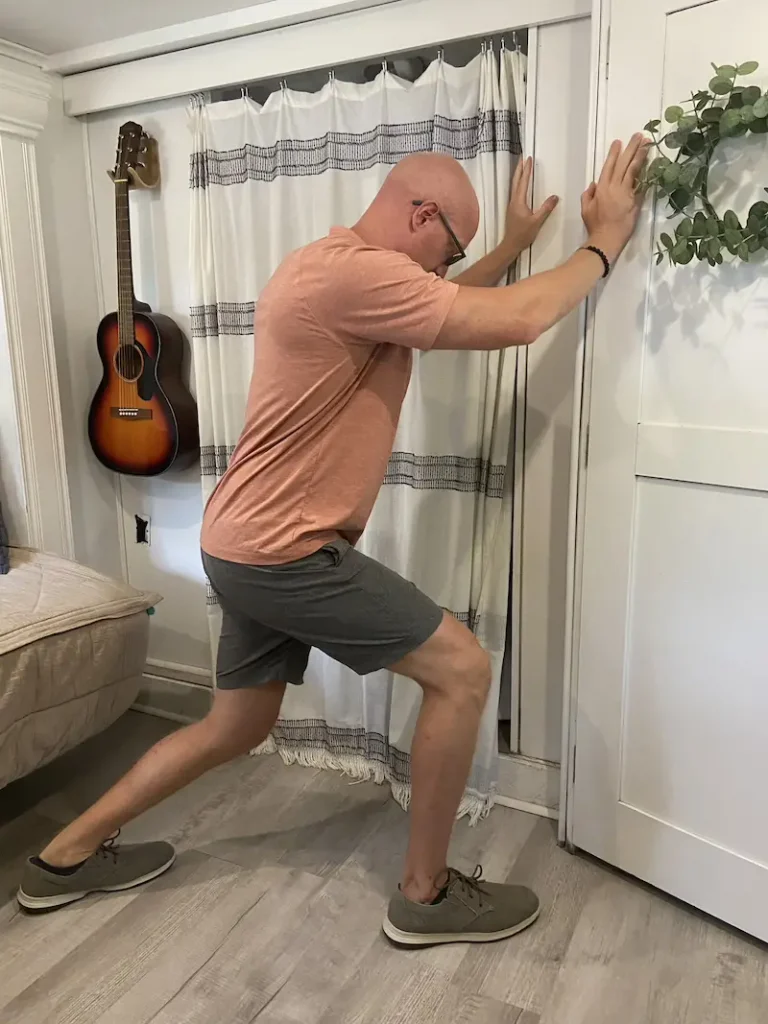
- Begin a standing lunge stretch with one foot forward and the other foot back. You’ll want the leg you’re trying to stretch in the back.
- Keeping both heels down. Bend the front knee slightly into a forward lunge and keep the back leg straight. This will target your calf muscle called the gastrocnemius.
- You should begin to feel a stretch in the back leg. Hold this for at least 30 seconds and up to 1 minute.
- Repeat the stretch, but this time allow a slight bend to the back knee (still keep the heels down).
- This targets a different calf muscle, called your soleus. Hold this for at least 30 seconds and up to 1 minute.
B. Plantar Fascia: Plantar Fascia Stretch
While this is a subtle stretch, it can be very effective for ensuring the plantar fascia and general muscles on the bottom of the foot don’t get too tight.
Although you can’t technically “stretch” the plantar fascia because of how thick and tough this connective tissue is, you can help lengthen it along with stretching the surrounding muscles on the bottom of the foot.
- While seated, cross one leg over the other. The foot needing to be stretched should be on top.
- Grab the bottom of the foot at the base of the toes with your hand.
- Gently pull back the foot and toes until you feel a stretch.
- Hold at least 30 seconds or up to 1 minute. Repeat on the other foot.
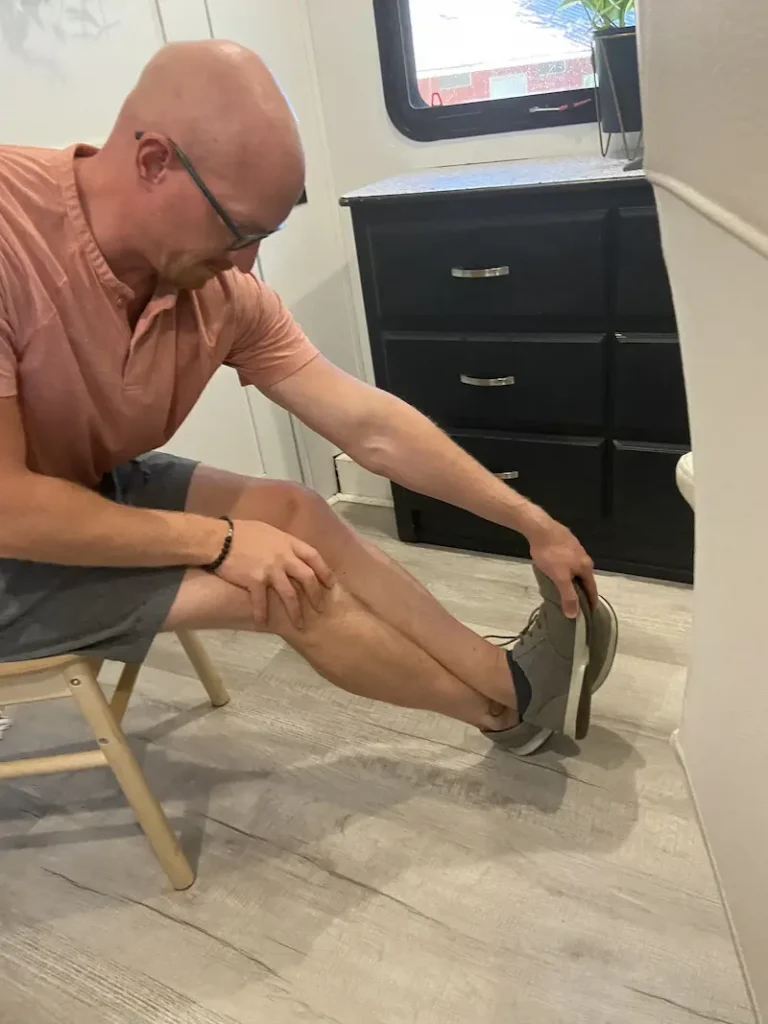
C. Shin: Shin Stretch
We many times forget about stretching the shins, but this is important not only for helping to correct foot supination, but also to help avoid shin splints. The primary muscle in the area of the shin is the anterior tibialis muscle.
During excessive supination, the toes tend to curl and crunch, which can make you more susceptible to shin splints. Stretching the anterior tibialis in this region can help treat and prevent this type of injury, as well as help to correct supination.
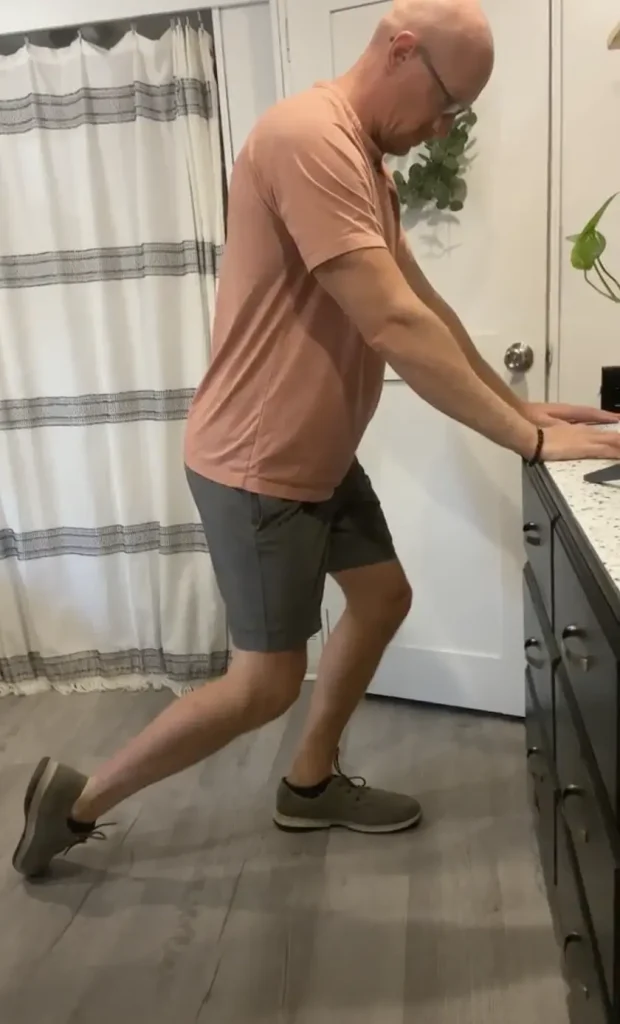
- Facing a wall or other sturdy surface, place your weight on one leg.
- Move the leg you’re stretching behind you.
- Move the foot so the tops of the toes are touching the floor.
- Move towards the floor into a kneeling position.
- Hold for at least 30 seconds or up to 1 minute.
Muscles to Strengthen To Correct Foot Supination
While tightness in the foot/ankle complex is a common cause of muscle imbalance leading to foot supination, there may also be weak muscles contributing to this misalignment anywhere along the leg.
A full evaluation from a qualified healthcare professional, such as your medical doctor or physical therapist, will help to identify all contributing areas of weakness; however, for today, we’ll key in on a couple specific areas and exercises you can start practicing.
1. Ankle Eversion with Resistance Band
This exercise is specific to the ankle and attempts to activate the muscles you may notice have become a little weak from excessive supination.
- Begin seated on the floor with your legs out in front of you.
- Have a resistance band held by someone, connected to something sturdy, or you can hold it with the opposite arm.
- Flex the foot and ankle back, then wing it away from the other leg. This is eversion.
- Slowly return to your starting position.
- Repeat 10-15 repetitions for 2-3 sets.
2. Reverse Lunge
This exercise provides a nice combination of a balance challenge, foot and ankle stability, and strengthening along the entire leg. You should notice a positive effect on your dynamic postural stability with this one.
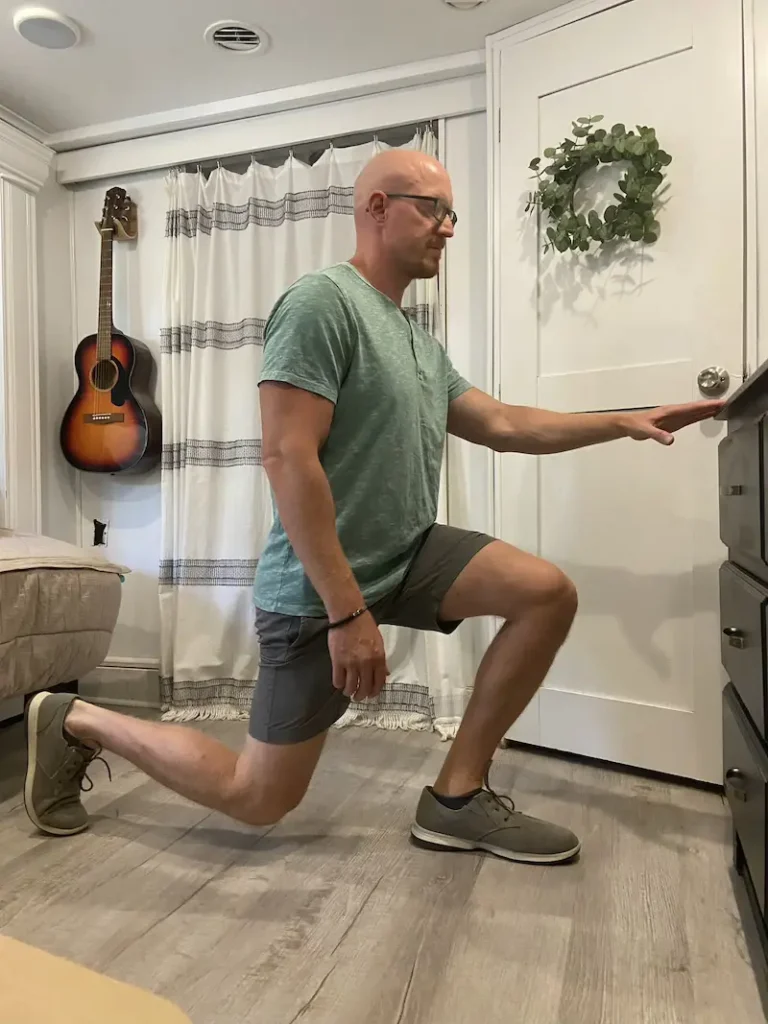
- Stand next to something sturdy in case you need to hold on for balance.
- Lift one leg off the floor so that you’re standing on the opposite leg. Hold this balanced position for about 2 seconds.
- Move the leg that’s in the air back into a lunge. Make sure the front knee and ankle are aligned.
- Push off with the back foot and return to your original starting position.
- Repeat 10-15 repetitions for 2-3 sets.
Be sure to check for proper form while doing this exercise. You’ll want to check the foot and ankle alignment during the reps, so it can be helpful to practice in front of a mirror.
3. Basic Squat
A squat is a great exercise to address leg strength but gives any opportunity to practice a dynamic motion while focusing to keep the feet and ankles in a neutral position.
- Consider practicing the squat facing a mirror to watch the alignment of the feet and ankles for proper form.
- Keep feet about hip width apart, with the toes pointing forward.
- As you begin to bend the knees, sit the hips back towards the heels. You should notice your torso slightly incline forward, which will help you balance. Your weight should favor the heels slightly.
- Squat to a depth that’s comfortable for the joints and hold anywhere from 2-5 seconds.
- Return to your upright starting position.
- Repeat 10-15 repetitions for 2-3 sets.

Other Considerations to Correct Supination
While exercise is a great start for correcting foot supination, you may need to take some additional measures as well.
Proper Footwear

It’s time for shoe shopping! Having the proper footwear can make a huge difference for correcting supination and possible pain you may be experiencing from it. You’ll want to make sure to use lightweight shoes versus something heavy or rigid (that’s part of the problem you’re already having with excessive supination!).
If you’re a runner and are looking for better running shoes to support you during your workout, it can be beneficial to consult with a store that specializes in athletic shoes or running shoes. Many of them have pretty good technology right in the store to check your posture and alignment, as well as identify any foot problems via a gait analysis.
In addition to the right shoes, you could also use orthotic inserts or custom orthotics in your shoes. These can assist in repositioning the foot/ankle into the correct position and alignment.
Professional Assessment

Sometimes you may need more advanced help. This is where a healthcare professional, such as your medical doctor or a physical therapist, can do a more in-depth assessment, such as a gait analysis, of your issue and make appropriate recommendations.
Conclusion
Excessive supination doesn’t have to be a debilitating issue. No matter what the cause is, maybe a structural or a functional imbalance, you can help the problem.
Give the above exercises a shot to treat supination, but also consider taking a look at your footwear and seeking an expert opinion.
These measures will allow you to take a well-rounded approach to get a true look at what is causing your foot supination and the best treatment plan.
FAQ:
-
How can I tell if I have too much foot supination?
An easy check is to look at the bottom of your shoes. If you have too much foot supination, you’ll notice more wear and tear on the outside edge of your shoes.
-
What brand of shoes is best for foot supination?
Honestly, this answer can vary for everyone. The best shoe for one person, may not be the best shoe for someone else.
Generally, make sure your shoe is lightweight and doesn’t feel too rigid.
Go to a specialty or athletic/running shoe store. Many have equipment in the store to check your alignment and weight placement on the feet and can make appropriate shoe recommendations for you to try.
-
How can I find out what exactly is causing my foot supination?
To find the true cause, it’s best to seek advice from an appropriate healthcare professional, such as your medical doctor or physical therapist.
They will be able to perform a specific assessment to identify all possible causes and contributing factors to your foot supination.


